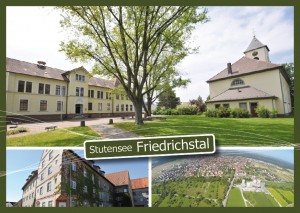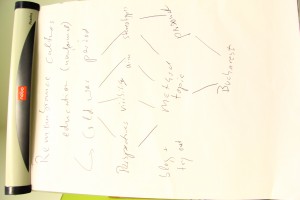The exercize
The participants are asked to take certain roles. If the topic is discrimination, this could for example be:
- the discriminated person
- the discriminating person
- someone related to the discriminated person
- someone related to the discriminating person
- a bystander, not related to any one of them.
At least two participants need to be ‘external observers’.
Frozen image: expression by body position, without dialogue or movement.
Step one: the tension situation
The roleplaying participants are asked to construct a frozen image that would depict a situation of discrimination. When the frozen image is constructed, the external observers are invited to describe what they see. Then one by one, the roleplaying participants are invited to finish two phrases:
– ‘How I feel right now is…’
– ‘What I need most right now is…’
Step two: tension resolved
The roleplaying participants are now asked to construct a frozen image that would depict the same situation, but now with the conflict/tension/discrimination resolved. Again, the observers are asked to describe their observations and the differences with the first situation. All roleplaying participants are invited to finish the phrase ‘How I feel now is…’.
Step three: analysis of the situation
Participants are asked to reflect on what they felt, what their thoughts were, what underlaying dynamics might have been in this situation and how this all relates to discrimination and the resolution of discrimination.
Variations and additions
An additional question for the observers during the frozen image might be:
– How about power dynamics? Who do you think is dominating and why?
During our try-out, the person who was embodying the discriminated person noticed that (as a white male) it was difficult for him to ‘get into the role’ of a person that experiences discrimination. We then asked someone who is actually repeatedly confronted with discrimination (a non-white female) to ‘sculpt’ the person in a body position that would reflect her experience and then asked the sculpted person to finish the phrase ‘How I feel right now is…’
To experience empowering, we then asked the white male person to sculpt the non-white female person into a body position that would reflect his experience and asked her to finish the phrase ‘How I feel right now is…’
Benefits of this method
Some of the benefits of this particular method mentioned by the participants were:
- less focus on talking – more feeling and acting
- offers the opportunity of developing empathy; and the opportunity to actually change a situation (at least within the play)
- shows the importance of body language
Risks of this method
Embodied work can be a very powerful method, so it also needs awareness of the risks and some precautions. Taking the time to build a safe container for this exercize is crucial.
- Body expression has a direct impact on our emotions and has the ability to call for strong emotions. If as a facilitator you would like to use a real-life experience as a situation, check with the participants if they feel okay with this, otherwise use an imaginary situation.
- People who need a ‘safe distance’ from the possible emotional impact of the exercize might feel more comfortable in the role of external observer.
- For some people, theater methods or embodied work might feel awkward. It helps if you start the session with a small energizer or exercize that involves body awareness and that loosens up body expression.
- Both the frozen images, the phrases as the anaysis will varie from group to group, as this exercize relates to personal views and experiences. Facilitators need to be flexible and sensitive to the needs of the group.
- Throughout the experience of (strong) emotions, this is also inner work that requires safety. A facilitator should be sensitive to the right timing, for example by planning this exercize at a moment that the participants know each other better than at the beginning of the training/workshop, or for example by only using topics/situations that might involve strong emotions if there is enough time for analysis and recovery after the frozen images.
- If the method of sculpting is used, check that participants are okay with touching and being touched. If participants feel uncomfortable with that, the sculptor can also give verbal instructions
Thoughts of participants about this method
- you need a very sensitive way to instruct this method, especially when you’re dealing with a real experience of a participant – but it can be really powerful and can lead to deeper reflections





